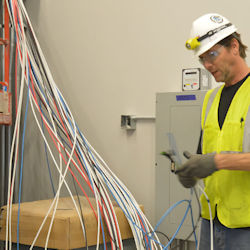Inadequate Wiring Hazards
An electrical wiring hazard exists when the wire is too small for the current it will carry or is not connected properly.
Normally, the circuit breaker in a circuit is matched to the wire size. However, in older wiring, branch lines to permanent ceiling light fixtures could be wired with a smaller gauge than the supply cable. Let's say a light fixture is replaced with another device that uses more current. The current capacity (ampacity) of the branch wire could be exceeded. When a wire is too small for the current it is supposed to carry, the wire will heat up. The heated wire could cause a fire.
When you use an extension cord, the size of the wire you are placing into the circuit may be too small for the equipment. The circuit breaker could be the right size for the circuit but not right for the smaller-gauge extension cord. A tool plugged into the extension cord may use more current than the cord can handle without tripping the circuit breaker. The wire will overheat and could cause a fire.
The kind of metal used as a conductor can cause an electrical hazard. Special care needs to be taken with aluminum wire. Since it is more brittle than copper, aluminum wire can crack and break more easily. Connections with aluminum wire can become loose and oxidize if not made properly, creating heat or arcing.
Case Study
A worker was attempting to correct an electrical problem involving two non-operational lamps. He examined the circuit in the area where he thought the problem was located. He had not shut off the power at the circuit breaker panel and did not test the wires to see if they were live. He was electrocuted when he grabbed the two live wires with his left hand. He collapsed to the floor and was found dead.
- Employers should not allow work to be done on electrical circuits unless an effective lock-out/tag-out program is in place.
- No work should be done on energized electrical circuits. Circuits must be shut off, locked out, and tagged out. Even then, you must test the circuit before beginning work to confirm that it is de-energized ("dead").
Knowledge Check Choose the best answer for the question.
5-2. Electrical wiring may become hazardous and cause arcing or fires if _____.
- the wires have too much insulation
- the wires are too long for the load
- the wire size is too small for the load
- the wires do not have in-line GFCIs
You forgot to answer the question!

